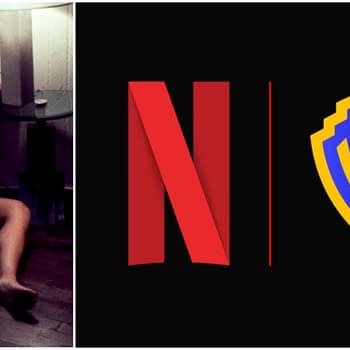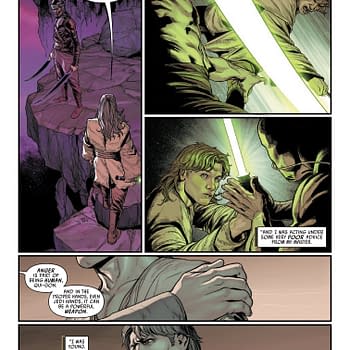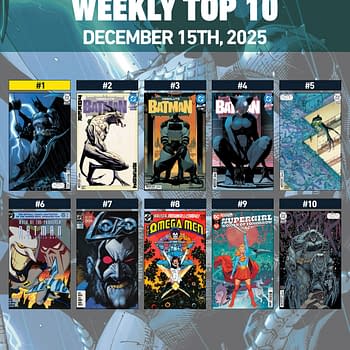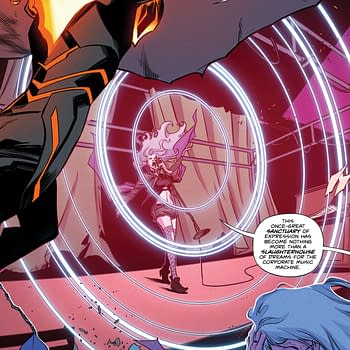Posted in: Comics | Tagged: Comics, David Avallone, dynamite, entertainment, the shadow, twilight zone
"Both Mete Out A Kind Of Justice." – David Avallone On The Connection Between The Twilight Zone And The Shadow
Dynamite has sent us a new Writer 2 Writer interivew, this time Frank Barbiere, writer of Dejah Thoris #5, talks with writer David Avallone about Twilight Zone: The Shadow #3, both in stores now. Cover is by Francesco Francavilla with interiors by Dave Acosta.

DAVID AVALLONE: The Twilight Zone and The Shadow have certain elements in common. I thought about that a lot when I was working on the book. Both are encountered by ordinary human beings at points of crisis in their lives, and judge them by how the react to their circumstances. Whereas The Twilight Zone is completely abstract, The Shadow is very present and personal… but both mete out a kind of justice. The big challenge here was that it's the Shadow being "judged" inside the Twilight Zone. And how does a guy with his powers and his responsibilities and his mission take to being toyed with by a seemingly omnipotent power, and judged? In issue #4, I finally answer that question. Stay tuned.
FB: You have a lot of fun with a surreal sequence in the book involving a writer becoming part of his work. What was your inspiration for this specific part of the story?
DA: It is notoriously difficult to dramatize writing, as an action. Ultimately it's a guy staring off into space, and then typing for a few minutes, and then staring off into space for a while. But what's happening in his head while he's staring off into space? That's where the drama is. And because I have the trappings of sci-fi/fantasy/horror to play with, I can make the internal psychodrama real: the writer inhabits his own memories, fantasies and nightmares.
On a beat-by-beat level, Art getting sucked into his typewriter was inspired to some degree by David Cronenberg's Naked Lunch film. Lots of anthropomorphized typewriters in that one. Kent Allard on the blank page, menaced by shifting characters, lost… that was actually inspired by a Daffy Duck cartoon: "Duck Amuck". And the giant typebars smashing down to spell the word "Justice" was inspired by Franz Kafka's short story "In The Penal Colony"…. which, like our story here, is about degrees of punishment, mercy and justice.

DA: Thanks! I actually try to eschew captions as much as I can: sort of like using voice over or title cards in movies, it seems like a short cut to me, or an admission that I couldn't get an idea across with dialogue or visuals. I like to do as little hand-holding of the audience as humanly possible, and let them "get it" without me coming out and explaining too much.
There are plenty of genius comics writers – I'm thinking of Alan Moore, for example – who can write thick paragraphs of prose captions that add tremendously to the book. For me, comics are a visual medium, and in the stories I've written so far, I have wanted to stick to images and dialogue as much as possible.
But. This is The Twilight Zone. And as a big fan of the original show, one of the highlights was always Rod Serling's introductions and final summations. They were always beautiful and poetic and thoughtful. Since The Twilight Zone – as a franchise – is pretty much just an abstract idea, I felt like the one concrete connection I could make to the series was to open and close each issue with my best approximation of Serling's style and "voice". If I weren't writing these, and just reading them like any other fan, I would want that.
FB: Do you feel this is leaning towards a more Shadow story or a Twilight Zone story? Do you feel any predominant elements rising to the surface?
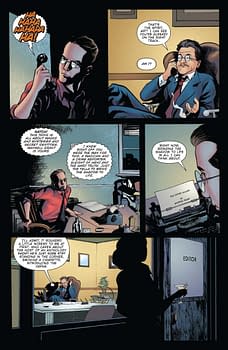
FB: What makes the comic medium a good fit for this story? Can you talk about how you approach deciding what to show on the page vs. text?
DA: I think I answered the second question back in my answer to number three, because I am – ironically – long-winded on the subject of not-being-long-winded-in-comic-books. As to the first, I think you could tell variations of this story in other formats, but when I'm plotting out a comic book issue or miniseries I give a lot of thought to the pacing, and that's where it gets tailored to the medium. This series in particular is designed to be episodic: The Shadow jumps into three different perspectives, with one issue devoted to each new perspective, ending in a cliffhanger revealing the next incoming change. Then in issue #4 we find out how that experience affected him.
If it was a single half hour Twilight Zone episode, it would probably have forced me to pick one of the perspective changes and run with that. In a novel, I'd have had a lot more time to explore the individual perspectives. In comic books, I find page 22 or 20 comes pretty fast and I'm always trying to get as much story in there as possible. I hope that pays off for the reader.










